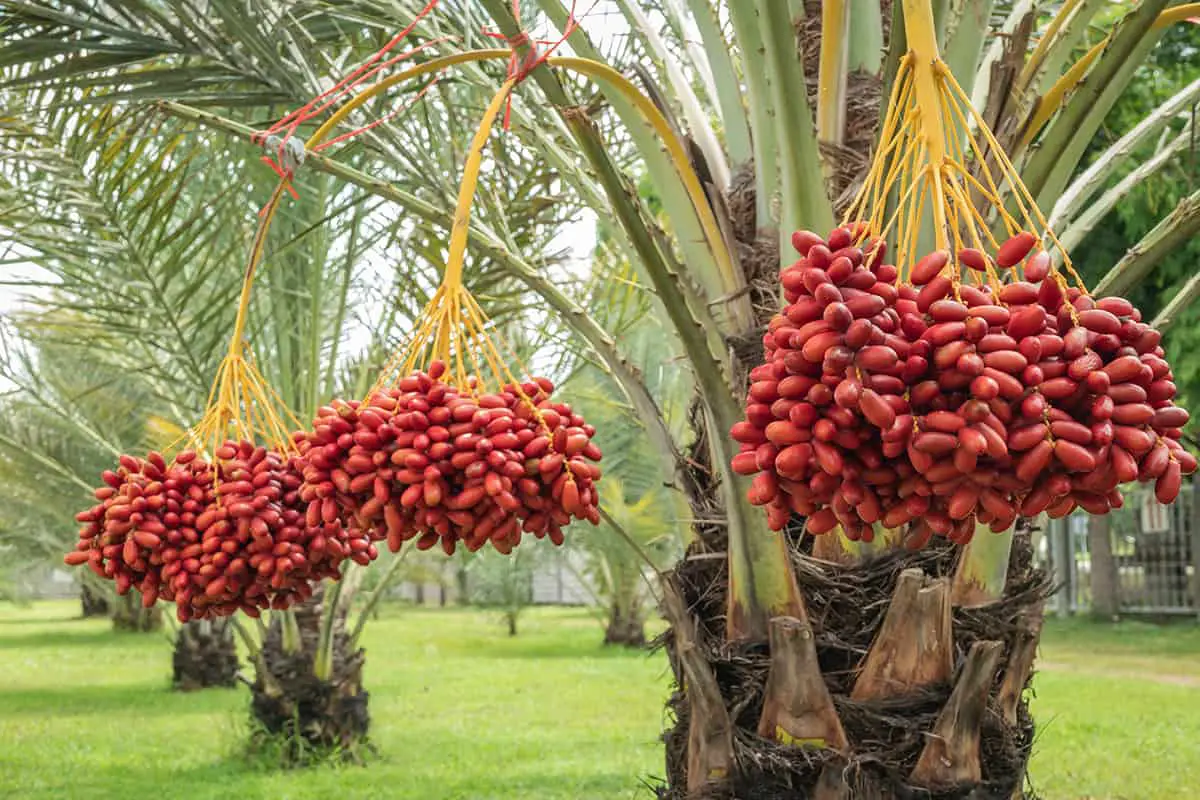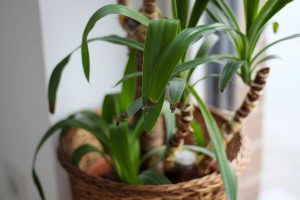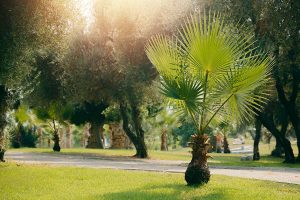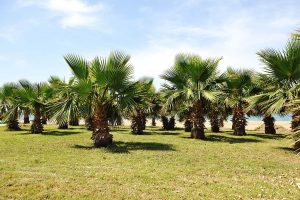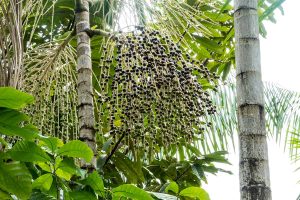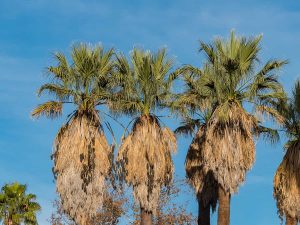Date palm trees are exquisite landscape trees that also offer the benefit of providing healthy and delicious fruits. These palms have long been cultivated in tropical and subtropical climates around the world, and they continue to be one of the most popular palm trees to grow in these regions. Here we look at the history of Date palms and how to care for them.
- Botanical name: Phoenix dactylifera
- Common names: Date Palm, Edible Date Palm
- Plant family: Arecaceae
- USDA hardiness zone: 9 – 11
- Mature height: 50 to 80 feet
- Mature spread: 20 to 40 feet
Table of Contents
What is a Date Palm?
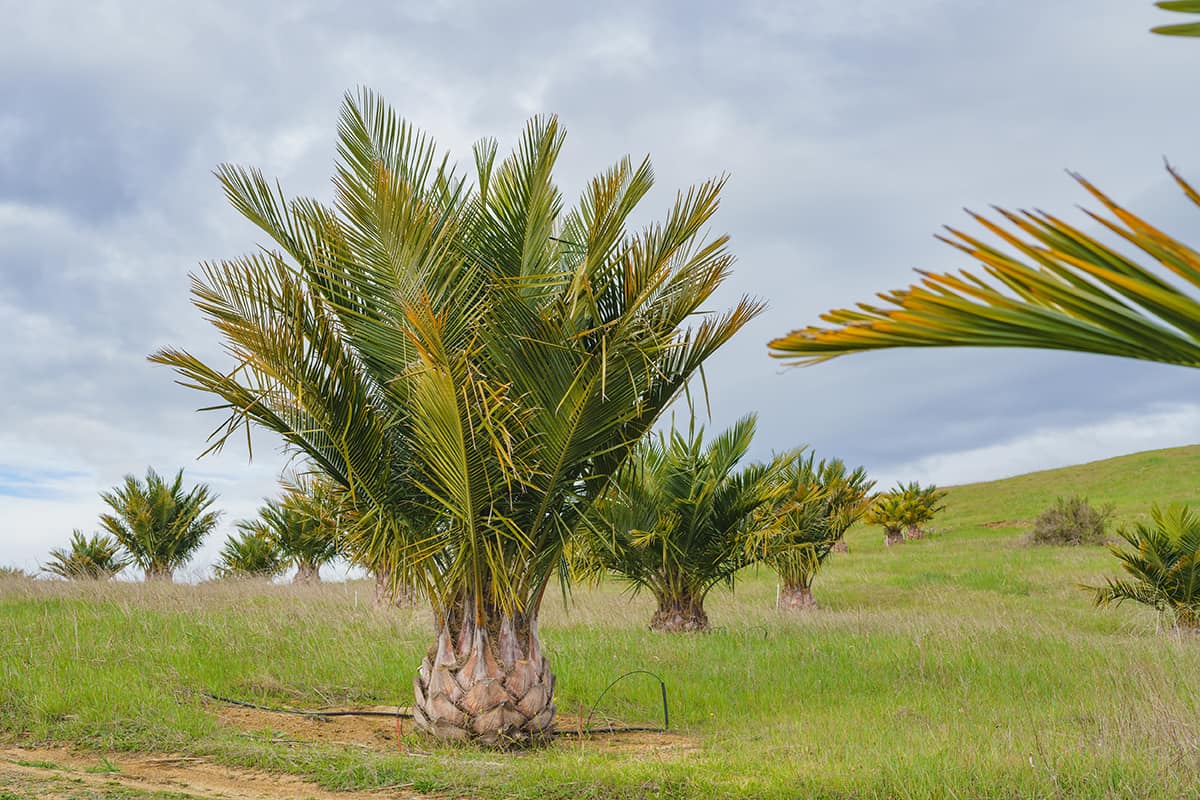
A Date palm is an evergreen tree native to the Arabian Peninsula and Northern Africa. It is one of the most recognizable palm trees in the world, having been cultivated for its fruit for thousands of years, to the point that it has been naturalized in many tropical and subtropical regions.
Date palms are slow growing, and have a life expectancy of around a century. They typically grow to between 50 and 80 feet in height, though it isn’t unusual for them to extend to 100 feet. Date palms have singular, long, and slender trunks with elegant crowns made up of arching fronds that can span up to 16 feet in length. The feathery fronds are pinnate, with each frond holding around 150 sharp and stiff leaflets. The fronds are gray-green with a waxy texture.
Each Date palm tree will have around 100 fronds at any one time. Date palm trees bloom with dangling panicles of creamy-colored flowers. While both male and female trees will bloom, it is only the female trees whose flowers develop into edible fruits. The clusters of drooping fruits are green at first, developing to showy shades of yellow, orange, red, or black as they ripen.
Date palm trees are widely cultivated for their fruits, which are sweet and sticky. They can be eaten fresh or dried and are also used in the making of syrups and alcohol.
Origins of the Date Palm Tree
The Date palm has been around for approximately 50 million year, and evidence shows that humans have been eating the fruits of the Date palm for around 200,000 years. Shahina Ghazanfar, a Science Research Leader at Kew Gardens, explains, “Stone tools and rock carvings discovered in the Nefud Desert in Northern Arabia show humans have been eating dates since the Middle Stone Age.
The date palm’s fruits are sweet and nutritious – and ripe dates don’t rot – making them one of the foods that ancient people could use and transport easily.” Date palms play a significant role in human history since they were one of the first crops to be cultivated when society transitioned from hunting and gathering to being responsible for growing their own crops around 11,000 years ago.
Today, the Date palm is essential to the agricultural foundation of the Middle East and Northern Africa. It provides a key source of food and also materials that can be used for trade or construction.
How to Care for Date Palm Tree
Date palms are low-maintenance trees in the right conditions. Here we explore how to care for these palms to get the best out of them.
Light
Date palms require full sunlight to thrive. As they are tall trees, this is usually easily achievable because there are few trees that will be tall enough to put the Date palm into a position of shade. Date palms can survive in partial shade, but this can affect their ability to readily produce fruit. Ideally, these trees need access to at least six hours of direct sun each day.
Soil
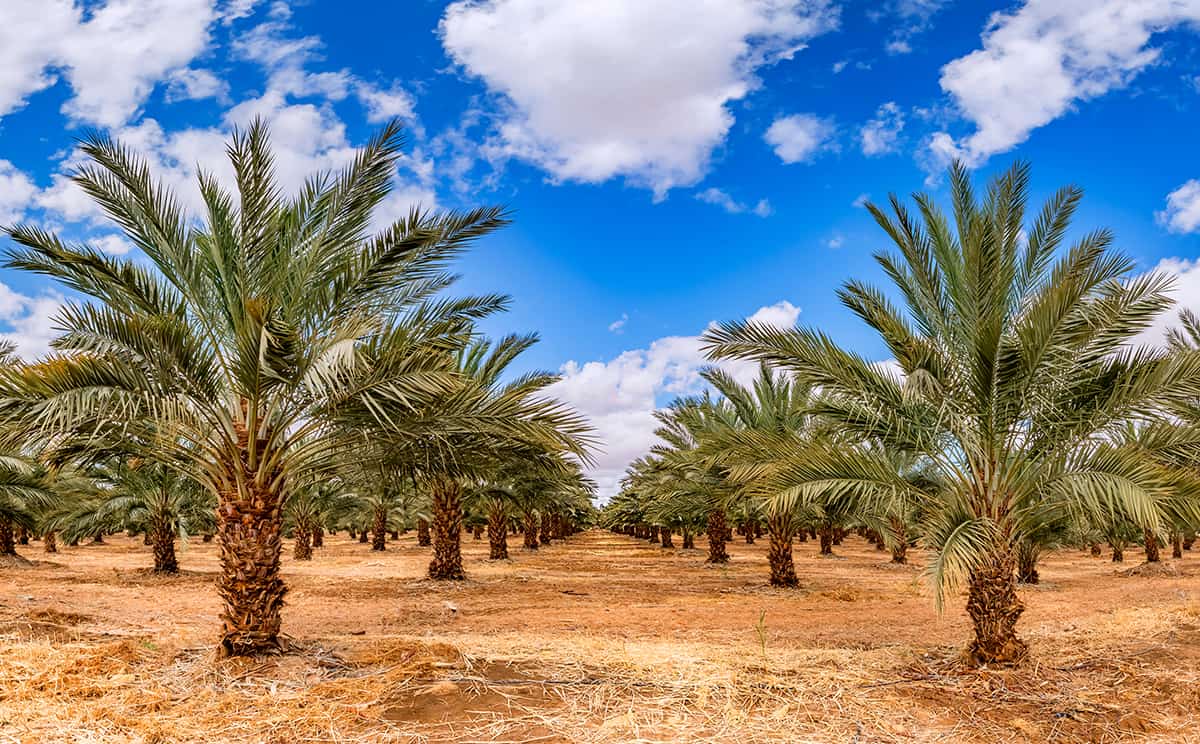
These palm trees thrive in sandy or loamy soil that drains well. Clay soil is not ideal as it can lack sufficient drainage, though it can be tolerated with some sand or gravel worked in. Though Date palms enjoy consistent moisture at their roots, they will come into problems if the soil is too wet. It is for this reason that drainage is essential for Date palms.
Water
Date palms have root systems that are deep and extensively spread out, so they can find their own source of water beneath the soil once roots are well established. This means that mature Date palms have a good level of drought tolerance, but younger specimens will need more regular irrigation.
For best results, generously water the soil around the Date palm throughout spring and summer, allowing it to almost dry out between each watering. For potted Date palms, more regular watering will be necessary as the roots of these trees are confined to the pots and, therefore can’t seek out other sources of moisture. When Date palms are in fruit, they should be watered more heavily, aiming for soil that is fairly consistently moist.
Temperature
Date palms need hot temperatures to thrive, especially if you want your tree to produce fruits. They will not pollinate until temperatures reach 95ºF, so a hot climate is essential for fruiting Date palms. In cold periods, Date palms are quite hardy, being able to survive short periods of frost and temperatures down to around 30ºF, though you can expect frond damage in low temperatures.
Humidity
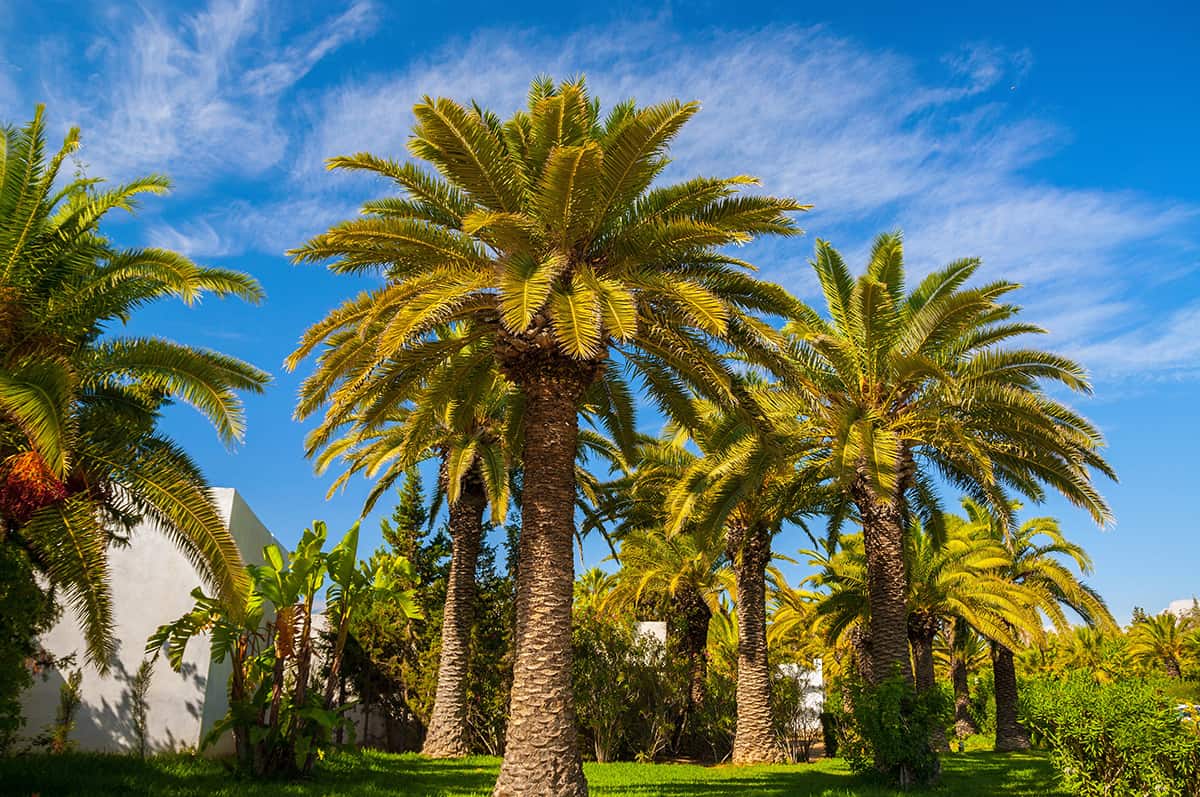
Humidity is not a requirement for Date palms, and in fact, they will perform much better in dry, desert-like conditions. Moist climates are not conducive to the production of fruit on these trees, and you will find that they are slow to bear fruit or produce a reduced amount of date fruits.
Fertilizer
Date palms thrive in fertile soils, so it’s a good idea to use fertilizer to increase their nutrient uptake, as well as work in organic content to improve the quality of the soil.
A fertilizer specially formulated for palms will work well, or any fertilizer which is high in potassium. Slow-release potassium-rich fertilizers are recommended for potted Date palms. Use well-rotted compost or manure as a top dressing around Date palms at any time of year to increase soil fertility.
Harvesting
Each Date palm will produce around 1000 date fruits each year, allowing for a long harvesting season that usually runs from September to December. The dates on a tree will not all ripen at the same time, so you’ll usually need to harvest by hand to pay attention to the ripeness of each individual fruit.
The dates are ripe when they have turned golden brown and can be pulled easily from the tree. At peak ripeness, the fruits will have optimum sugar and flavor levels.
Date Palm Tree FAQs
Are Date Fruits Good for You?
Date fruits offer a multitude of health benefits, being high in fiber, protein, and a range of vitamins and minerals. They are known to improve bone health and gut health, and they are also recommended to be consumed by pregnant women to strengthen the pelvic muscles to increase the likelihood of natural birth.
A 30g portion of dates counts as one portion of an adult’s recommended 5-a-day fruit and vegetable intake. Dates contain high levels of natural sugars, so they can be a healthier alternative to other sweeteners.
How Far Apart Should Date Palms Be Spaced?
When planting Date palms you’ll want to take into account their expected mature size to allow enough room for them to grow. As Date palms can have a spread of between 20 to 40 feet, they will need to be planted between 10 and 20 feet from any nearby structures such as houses, and if you are planting several Date palms then there should be 20 to 40 feet between each palm.
If you are growing Date palms to cultivate their fruit, then you’ll need to make sure you have at least one male Date palm nearby in order for the female palms to fruit. A ratio of at least one male Date palm to every six female Date palms works well.
Can Date Palms be Propagated?
Date palms can be propagated by using the shoots from existing palm trees. On mature Date palms, suckers will emerge from the base of the tree. Carefully remove the sucker, keeping as many of the roots attached as possible, and plant this into some new soil mix. Position the planted sucker in full sunlight and keep the soil moist but not wet, and wait for new shoots to appear. Alternatively, Date palms can be grown from seed.
You can buy Date palm seeds or harvest seeds from ripe date fruits. Submerge the seeds in water for 24 hours, and then gently press them into a tray of shallow soil. Spritz the soil with a water mister to keep the soil moist but not wet, and set them in a bright spot. The soil will need to be spritzed with water regularly to maintain evenly moist soil for one to four months.
During this time, the seeds should have germinated and when the sprouts are several inches tall they can be moved to individual pots. Continue with the same care until the young Date palms are established enough to be grown in the ground or a permanent planter.
